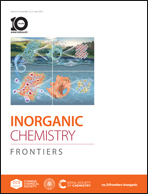Significant surface-enhanced Raman scattering effect of Ag-loaded iron hydroxide enabled by coordination effect between Ag and hydroxyl group†
Abstract
The effective monitoring of trace carcinogens in the environment and daily necessities is very important for humans. Here, Ag-loaded iron hydroxide (Ag/Fe(OH)3) was designed as an excellent surface-enhanced Raman scattering (SERS) substrate and used for the trace detection of carcinogenic aromatic amine p-aminoazobenzene (PAAB). Due to the weak binding ability of Fe3+ with OH−, Fe(OH)3 presents a strong coordination ability with Ag than Co(OH)2 and Ni(OH)2, resulting in the prominent adjustability of Ag/Fe(OH)3, including the localized surface plasmon resonance (LSPR) property and energy band structure. On the one hand, the dielectric environment of Ag nanoparticles is changed due to the coordination effect of Ag and OH−, among which the LSPR of Ag/Fe(OH)3 in the visible region is significantly enhanced. On the other hand, the energy band gap of Ag/Fe(OH)3 is reduced by increasing the content of Ag, achieving effective photo-induced charge transfer (PICT) under excitation at 633 nm. Comprehensively, an enhancement factor (EF) of 1.23 × 106 was achieved for 4-ATP molecules through the synergistic interaction of LSPR and PICT. Importantly, Ag/Fe(OH)3 presents an ultra-low detection limit for PAAB (10−9 M), which is of great significance for the trace detection of carcinogenic aromatic amines.



 Please wait while we load your content...
Please wait while we load your content...